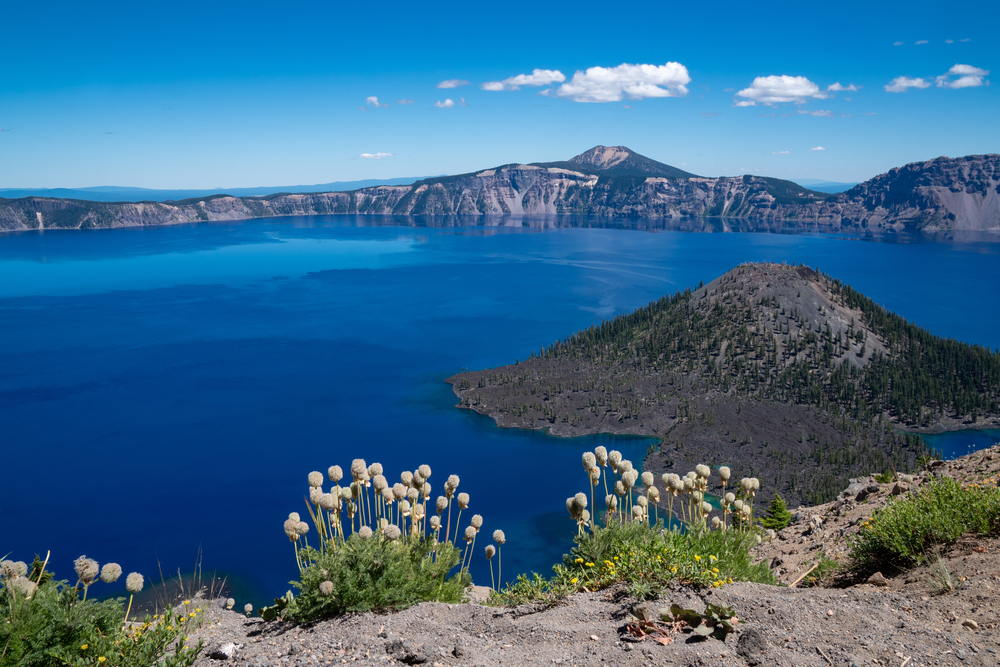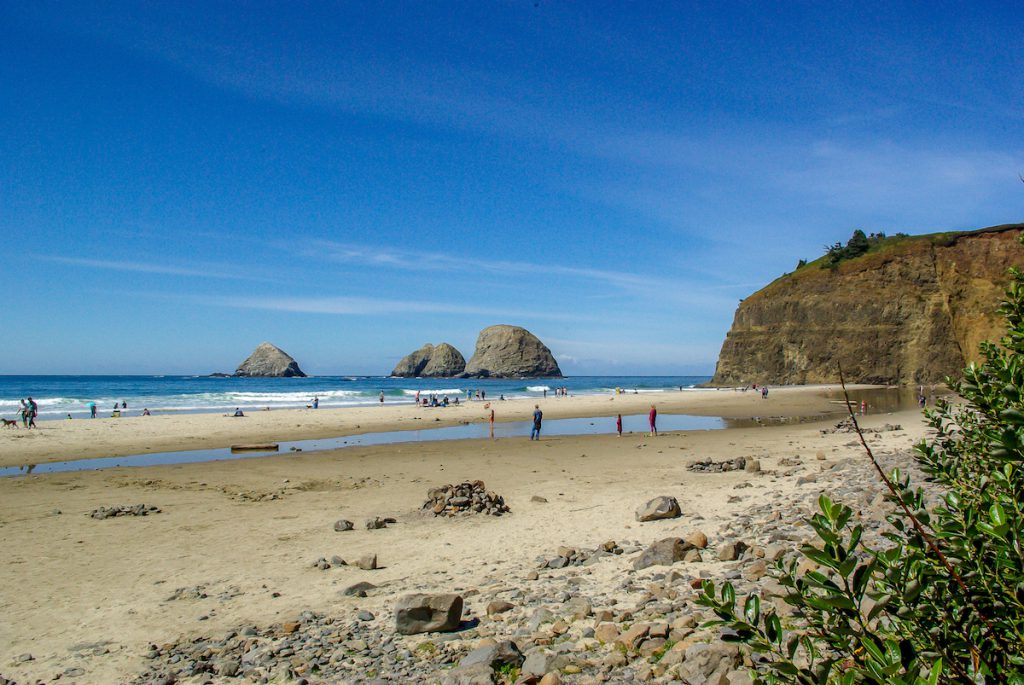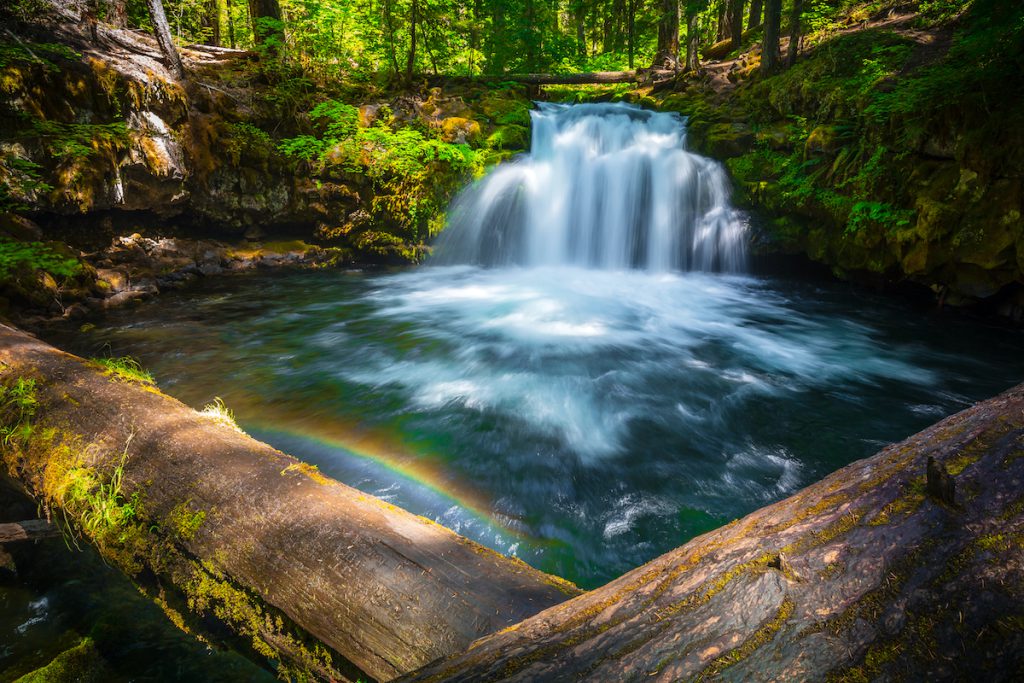
Oregon is a gorgeous Pacific Northwest state to explore by RV! There are lots of things to see here, from the sandy beaches along the coast to the awe-inspiring Columbia River Gorge to the deepest lake in the United States. You can also spend time in funky Portland or the college towns of Corvallis and Eugene. Whether you’re visiting Oregon on its own, or stopping on a trip up or down the coast, you’ll find lots to entertain you!
Preparing for RV Camping
The first step to prepping for an RV camping trip to Oregon is to make sure you have an RV! If you don’t have your own, you can rent an RV from RVshare. After you have your RV squared away, you can figure out what you’ll need to pack in it for a successful camping trip.
Choosing the right RV for your needs
As you think about renting an RV, you’ll want to consider a few things while determining which RV you wish to rent. First, you’ll need to think about the size of your family or group. If there are just one or two people camping, you may want a campervan or pop-up trailer. You’ll need a Class A motorhome or fifth-wheel wheel trailer if you have a large group. An average-size family can easily fit in a Class C camper or a smaller travel trailer.
You’ll also want to think about your amenities. Smaller campervans and trailers may not have much more than a bed. Large Class A rigs have perks like indoor bathrooms (sometimes more than one!), entertainment areas, and even a fireplace or washing machine.
Finally, you’ll want to consider whether you need an extra vehicle. How will you get around once you’ve set up camp? If you have a trailer, you can use your towing vehicle once it’s unhitched. You can drive a campervan around and set it back up at camp each night. If you’re camping in a large motorhome, you may need to tow another vehicle behind you or make sure you’re near public transportation or a park shuttle to get around.
Packing essentials for a successful trip
When packing for an RV camping trip, you’ll want to bring everything you need without overpacking and needlessly weighing down your RV. You might even want to make two packing lists – one for your personal items and one for everything you need in an RV.
Personal Packing List:
- Clothing – be sure to pack enough for your trip, or enough for between laundry days
- Toiletries
- Medications
- Bug spray or citronella candles
- Sunscreen
- First Aid kit
- Outdoor recreation clothing (hiking boots, bathing suit, or other specialized clothing)
- Winter or summer accessories (winter hats, gloves, sun hat, etc)
- Flashlight
- Entertainment (books, games, movies)
- Extra batteries
- Groceries
- Electronics & chargers
- Pet supplies
- Quarters for showers or laundry
Before you begin packing your RV, check the listing for your rental to see what, if anything, is included. Some rentals include dishes, linens, and even outdoor equipment, while others don’t include any extras. Once you know what comes with your rental, you can plan the rest of your supplies.
RV Packing List:
- Pots & pans
- Dishes
- Utensils – don’t forget a can opener, bottle opener, spatula, set of knives, etc.
- Dish towels & sponges
- Sheets & pillows
- Bath Towels
- Tool kit
- Folding camp chairs
- Blankets
- RV leveling blocks
- Sewer hose and adapter
- Freshwater hose
- Surge protector
You’ll also want to consider where you’re traveling and what time of year you’ll be there, and you may need to adjust your list accordingly. Be sure to check our RV Checklist to ensure you don’t forget anything!

Considerations for Camping in Oregon
You’ll want to be aware of Oregon’s laws for RVs and trailers as you drive through the state. Although most laws are similar, each state has its own laws governing RVs and trailers. You’ll want to make sure you know what Oregon’s are to avoid getting a ticket.
In Oregon, your RV can have a maximum width of 102 inches and a maximum trailer length of 45 feet. The maximum length of a two-vehicle combination is 65 feet. Riding in truck campers is allowed. Passengers are also allowed in fifth-wheel trailers if the trailer has safety-glazed windows, a signaling device passengers can use to get the driver’s attention, and an unobstructed exit they can use.
Trailers must have full lighting equipment. Any combination of a motor vehicle and another vehicle should have a brake system capable of stopping them both from 20 mph without leaving a 12-foot wide travel lane. Headlights should be on for limited-visibility conditions of 1,000 feet or less. A right turn is allowed on red after coming to a complete stop.
Researching campground options and making reservations
Now that you have an RV and know what to pack in it, it’s time to start looking at RV campgrounds in Oregon. You can find out most of what you need to know from a few helpful websites. BookOutdoors, The Dyrt, RoverPass, and Campspot can all give you information about Oregon campgrounds and help you book a reservation online. Hipcamp and Harvest Hosts offer more unique places to stay, like farms or wineries. KOA and Jellystone campgrounds are great options for families who want all the amenities plus activities to do within the camp.
Finding Campgrounds
There are lots of campgrounds in the beautiful state of Oregon! You can narrow down your search based on where you want to visit in the state, how much you wish to pay, and which amenities you desire. Whether you like luxury camping, camping at public campgrounds, or urban camping, you’ll find somewhere that’s perfect for you!
Exploring public campgrounds in the state
The first campgrounds to consider are public campgrounds in Oregon. You’ll find public campgrounds in national parks, national forests, and on Bureau of Land Management land. Public campgrounds are usually less expensive than private campgrounds, but they often also have fewer perks like showers or laundry facilities.

National Park Camping
Oregon is home to one national park – Crater Lake National Park. Crater Lake is the deepest – and some would say the clearest – lake in the United States. You can hike to the bottom of the lake (and even swim in it!) or view it from many overlooks around the rim.
Oregon also has other monuments and sites. They include:
- California National Historic Trail
- Fort Vancouver National Historic Site
- Ice Age Floods National Geologic Trail
- John Day Fossil Beds National Monument
- Lewis & Clark National & State Historical Parks
- Nez Perce National Historical Park
- Oregon National Historic Trail
- Oregon Caves National Monument & Preserve
Some of these sites have campgrounds, but others are day-use-only sites, and you would need to find a private campground nearby.
National Forest Camping
You can also camp at public campgrounds in the national forests in Oregon. Mount Hood National Forest has alpine lakes, ski areas, and the impressive Timberline Lodge. The Rogue River-Siskiyou National Forest is near the California border, and you can explore the Oregon Caves or raft the Rogue River. The Willamette National Forest is east of Eugene and has hiking trails, waterfalls, rivers, and lakes. The Willamette Valley is also known for its many vineyards and wineries.

State Park Camping
Oregon’s state parks are another great place to camp! Cape Lookout State Park is along the beach and has lovely ocean views. Silver Falls State Park has ten waterfalls, including a waterfall you can walk behind. You can also hike, bike, and horseback ride. Milo McIver State Park has canoeing and kayaking on the Clackamas River and is a great spot for fishing.
Bureau of Land Management (BLM) Camping
You can also camp on BLM land in Oregon. These are often some of the most inexpensive – or even free – campsites. Rainie Falls Trail has lots of places nearby with dispersed camping available. Susan Creek Campground is along the North Umpqua River. It has towering trees, rushing waterfalls, and serene lakes. Three Bears Recreation Site is near a river and tucked into a red cedar grove. You can hike, swim, and watch for wildlife.
Exploring private campgrounds and RV parks
Private campgrounds in Oregon are also an excellent option for a camping trip! These tend to have more perks like WiFi, showers, laundry, hookups, or even just dump stations that public campgrounds don’t always have. You can also find campgrounds for glamping if you want to be truly pampered. Umpqua’s Last Resort has RV sites and glamping tents along the North Umpqua River. The Sunny Valley RV Park and Campground is near the base of Mount Sexton and has RV sites, cabins, or covered wagons where you can stay.
Shelter Cove Resort and Marina along Odell Lake is a wonderful campground for a weekend getaway. Oceanside Beachfront RV Resort is perfect if you want to camp near the beach in Coos Bay.
Boondocking in Oregon
If you want the opposite of a glamping trip, you can also go boondocking in Oregon! You’ll have tons of choices for boondocking sites, but Huckleberry City is one beautiful, wooded area that’s a great spot for camping. Mayfield Pond Recreation Area is another excellent choice for boondocking. Make sure you know the basics of boondocking and have plenty of water and power for your trip without needing hookups.
Planning your itinerary
Now that you’ve decided on a campground for your Oregon camping trip, it’s time to decide what to do! Oregon’s vast array of museums, parks, cities, amusement parks, and other attractions means you’ll be able to find something to do, no matter your interests. Here are a few of our favorite choices for Oregon activities.
Features and attractions in Oregon
One of the best ways to see Oregon’s sights is by taking a scenic drive in the state. The Lower Deschutes River Back Country Byway follows the east bank of the Lower Deschutes Wild and Scenic River. You’ll get views of raging rapids and steep canyons. You can also see Sherars Falls along the drive.
You’ll want to see some of Oregon’s landmarks while you’re in the state as well. Multnomah Falls is a 620-foot waterfall and a popular spot for pictures. Bagby Hot Springs has cedar tubs where you can soak in healing waters. Lost Lake at Willamette National Forest is the site of an unusual phenomenon, where the lake that fills up each winter drains itself into the earth.
There are also lots of national sites in Oregon, like the Nez Perce National Historical Park and the Fort Vancouver National Historic Site.
Festivals, fairs, and events in Oregon
You might want to plan your RV camping trip in Oregon around an event, such as a festival, in the state. The Oregon Brewers Festival takes place in Portland each summer and celebrates Oregon’s famed craft beer scene. The Oregon State Fair happens in Salem each August, helping to wrap up the end of summer.
If you want to attend an event in Oregon, it’s possible your rental owner might set up your RV at the campsite for you. Many owners offer this service for an extra fee, and it means you can arrive and head straight to the fun!

Exploring Outdoor Activities in Oregon
If you plan to spend lots of time outdoors on your camping trip, you’re in the right place! Oregon has plenty of outdoor activities to try, from whitewater rafting to hiking to mountain biking in summer. In winter, you can ski, snowshoe, snowmobile, and more.
Hiking, biking, and nature trails
You can experience Oregon’s natural beauty on amazing hikes and bike rides in the state! Here are some of the best hiking trails in the state.
If you enjoy mountain biking instead, here are some great trails to explore!
- Tamolitch Blue Pool via McKenzie River Trail
- Misery Ridge and Summit Trail Loop
- Crooked River Trail
- Koosah and Sahalie Falls Trail
- Deschutes River South Canyon Trail
Fishing, boating, and water activities
If you’d like to spend part of your Oregon camping trip on the water, there are many options for you! You can go fishing on one of Oregon’s lakes like Diamond Lake or head to the Necanicum River. Unwind at one of Oregon’s top beaches, which include Cannon Beach and Gold Beach. Or you could spend the day looking for Oregon’s rushing waterfalls like Salt Creek Falls or Punch Bowl Falls.
Wildlife viewing and photography
There is lots of thriving wildlife in Oregon! At the national and state parks and wildlife refuges, look for elk, bears, skunks, otters, mountain lions, mountain goats, and many other animals. Watch for puffins, seals, whales, dolphins, and other water-loving birds and animals at the coast. You can also seek out tidepools and see what sort of underwater life is making themselves at home.
Family-friendly activities and attractions
Headed on your Oregon RV camping trip with kids? There are tons of family-friendly things to do in the state! Whether you’re headed to a city like Portland or Bend, to a park, or to a museum or other site, you’ll find lots to entertain everyone in your group.
Historical sites and museums
You can learn and have an entertaining visit at a national site in Oregon. Explore the colorful rock formations at John Day Fossil Beds National Monument or venture into the Oregon Caves National Monument and Preserve.
Oregon also has some amazing museums for more learning. Some of the best are:
- Oregon Museum of Science and Industry
- Evergreen Aviation and Space Museum
- Museum of Mental Health
- Portland Art Museum
- Columbia Gorge Discovery Center
Amusement parks, zoos, and wildlife refuges
You could also spend a day at an exciting amusement park in Oregon! Oaks Amusement Park in Portland has a train, a carousel, and other kiddie rides for the youngest visitors. Older kids might love the thrill of the Disk’O spinning ride, or the Adrenaline Peak roller coaster. You can also play midway games or get in a round of mini-golf.
If you’d rather hit the zoo, the Oregon Zoo in Portland has 230 species and more than 1800 animals to visit. You could definitely spend an entire day here and not see everything! The Oregon Coast Aquarium features marine animals and focuses on animals living along Oregon’s coast. You’ll see otters, harbor seals, octopi, sea lions, and more.
You can watch for animals in their natural habitat at an Oregon wildlife refuge. Baskett Slough National Wildlife Refuge was established to protect Canada geese, which winter in the Willamette Valley. You can also watch for the Fender’s blue butterfly atop Baskett Butte. Oregon Islands National Wildlife Refuge has an estuary and is home to puffins, harbor seals, Chinook salmon, a variety of birds, and many more animals.

Safety and Preparedness when RV Camping in Oregon
You’ll love your RV camping trip in Oregon, but you should be aware of the weather conditions and natural disaster threats in the state. That way, you can be prepared if you do face an emergency!
Weather conditions and natural disaster preparedness
Common national disasters in Oregon include floods, earthquakes, tsunamis, and wildfires. If you are in Oregon when an earthquake strikes, seek shelter under a table and away from heavy light fixtures or windows that could break. If your RV is parked near light poles or trees that could fall and crush it, you may want to run outside during an earthquake. Have flashlights ready to use after an earthquake, and do not light any matches or fires in case of gas leaks. Listen for tsunami warnings and head inland if you hear of a possible tsunami.
If there is flooding in Oregon, head to higher ground. Be careful when driving – flooded areas can look deceptively shallow!
Take precautions during wildfire season as well. Know the fire restrictions for your campground and know how to safely start and put out a campfire if you are allowed to have one. Finally, check weather reports and advice from local authorities. You don’t want to be starting a campfire on a dry, windy day, for example!
Wildlife encounters and precautions
Oregon is home to bears, mountain lions, and other predators. If you’re hiking, don’t let children or pets run ahead on the trail. Watch for posted signs and follow their instructions on what to do if you see a wild animal. Also, use the thumb trick to make sure you are far enough away from an animal. Extend your arm in front of you, and give a “thumbs up” blocking the animal. If you can still see parts of the animal around your thumb, you’re too close!
An RV camping trip to Oregon is a wonderful way to spend a vacation! There are so many things to see in this beautiful state, and you’re sure to make lifelong memories while you’re here.
More Inspiration for Your Oregon Travels:
If you’re looking for even more advice on where to go and what to do, check out some of our other articles!
- Top 6 Amusement Parks in Oregon
- Urban Camping in Oregon
- Top 10 Waterfalls in Oregon
- Luxury Camping in Oregon
- Glamping in Oregon
- Fishing in Oregon
- Top 10 Beaches in Oregon
- Top 31 Bucket List Destinations in Oregon
- Boondocking in Oregon
- Top 10 Landmarks in Oregon
- The 10 Best RV Trips To Take In Oregon
This post may contain affiliate links.
